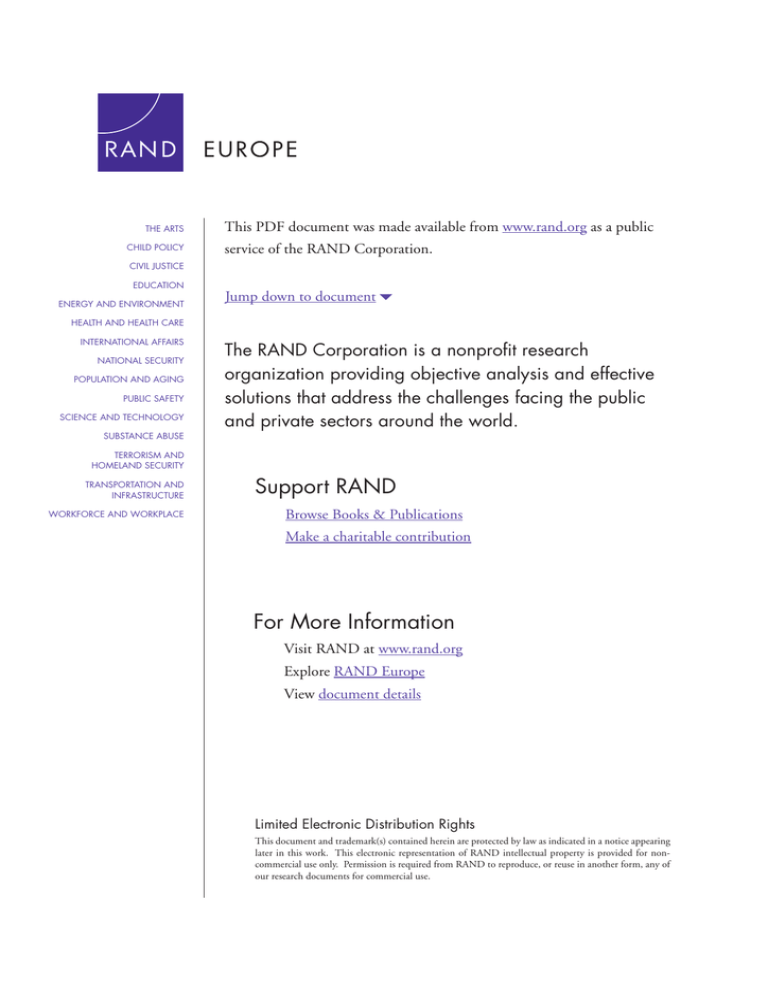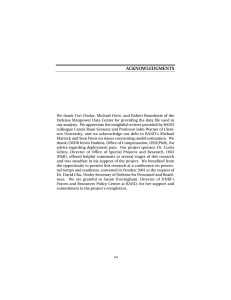
THE ARTS
CHILD POLICY
This PDF document was made available from www.rand.org as a public
service of the RAND Corporation.
CIVIL JUSTICE
EDUCATION
ENERGY AND ENVIRONMENT
Jump down to document6
HEALTH AND HEALTH CARE
INTERNATIONAL AFFAIRS
NATIONAL SECURITY
POPULATION AND AGING
PUBLIC SAFETY
SCIENCE AND TECHNOLOGY
SUBSTANCE ABUSE
The RAND Corporation is a nonprofit research
organization providing objective analysis and effective
solutions that address the challenges facing the public
and private sectors around the world.
TERRORISM AND
HOMELAND SECURITY
TRANSPORTATION AND
INFRASTRUCTURE
WORKFORCE AND WORKPLACE
Support RAND
Browse Books & Publications
Make a charitable contribution
For More Information
Visit RAND at www.rand.org
Explore RAND Europe
View document details
Limited Electronic Distribution Rights
This document and trademark(s) contained herein are protected by law as indicated in a notice appearing
later in this work. This electronic representation of RAND intellectual property is provided for noncommercial use only. Permission is required from RAND to reproduce, or reuse in another form, any of
our research documents for commercial use.
This product is part of the RAND Corporation technical report series. Reports may
include research findings on a specific topic that is limited in scope; present discussions of the methodology employed in research; provide literature reviews, survey
instruments, modeling exercises, guidelines for practitioners and research professionals, and supporting documentation; or deliver preliminary findings. All RAND
reports undergo rigorous peer review to ensure that they meet high standards for research quality and objectivity.
Security Challenges to the
Use and Deployment of
Disruptive Technologies
Neil Robinson, Maarten Botterman, Lorenzo Valeri,
David Ortiz, Andreas Litgvoet, Rebecca Shoob, Eddy
Nason
Prepared for the European Commission
The research described in this paper was prepared for the European Commission. The
opinions expressed in this study are those of the authors and do not necessarily reflect the
views of the European Commission.
The RAND Corporation is a nonprofit research organization providing objective analysis
and effective solutions that address the challenges facing the public and private sectors
around the world. RAND’s publications do not necessarily reflect the opinions of its
research clients and sponsors.
R® is a registered trademark.
© Copyright 2007 RAND Corporation
All rights reserved. No part of this book may be reproduced in any form by any electronic or
mechanical means (including photocopying, recording, or information storage and retrieval)
without permission in writing from RAND.
Published 2007 by the RAND Corporation
1776 Main Street, P.O. Box 2138, Santa Monica, CA 90407-2138
1200 South Hayes Street, Arlington, VA 22202-5050
4570 Fifth Avenue, Suite 600, Pittsburgh, PA 15213-2665
Westbrook Centre, Milton Road, Cambridge CB4 1YG, United Kingdom
RAND URL: http://www.rand.org/
RAND Europe URL: http://www.rand.org/randeurope
To order RAND documents or to obtain additional information, contact
Distribution Services: Telephone: (310) 451-7002;
Fax: (310) 451-6915; Email: order@rand.org
Executive Summary
This report considers the security challenges to the use and deployment of disruptive
technologies, which is a business and technology concept devised by Harvard professor
Clayton M Christiansen. Disruptive technologies are those that sacrifice certain qualities in
a product that are attractive to the majority of customers in favour of a different set of
characteristics which may only be attractive to certain customers or which fulfil a certain
specific niche need. Disruptive technologies or innovations are different from ‘sustaining
innovations’. Sustaining innovations maintain a constant rate of product improvement,
leading to increasing functionality for the greatest number, or most profitable, customers.
Disruptive technology can also create new markets by radically changing the market
landscape, for instance, allowing new players to enter the market.
In trying to understand the security challenges associated with the use of these
technologies, this report considers five specific disruptive technologies: Voice over Internet
Protocol (VoIP); Radio Frequency Identification technology (RFID); Wireless Microwave
Access (WiMAX); Trusted Computing and Internet Protocol version 6 (IPv6). Each
technology was considered in the light of an implementation within an organisation, as a
discrete case study.
To undertake the research, experts in Information Communications Technology (ICT)
and information security were asked to participate in a Delphi exercise and workshop,
where they rated their views on the security challenges to the deployment and use of the
disruptive technologies. Overall, the research indicated that complex social and economic
issues such as trust, risk and privacy were the most prevalent concerns. The experts also
considered the business drivers for the implementation of these technologies, as security
must always be seen in the light of hard-nosed business decisions. Following the
classification of the different types of security challenges, the experts then helped in the
design of a study framework that was used to guide the data collection for the case studies.
The case studies of the implementation of the five technologies were conducted in specific
organisational settings. A combination of desk research, review of organisational
documentation and first-hand interviews were used to collect the data, which was then
reviewed and compared to other evidence.
The evidence showed that:
•
The business case for the deployment of these disruptive technologies is not yet
fully developed. As a result of this, the security considerations of the deployment
v
of these technologies may not be treated as seriously as they should, since these
tend to be secondary to business concerns.
•
Disruptive technologies present security challenges when organisations must
transition from one version of the technology to another. These transitions must
be properly managed if security is not to be undermined.
•
The perception of the end user is an important issue, as it relates directly to
usability and can also indicate how well the security message is understood.
•
These technologies throw up reliability challenges; in particular as some of these
technologies are key elements of the evolving European information infrastructure
upon which governments, business and citizens increasingly rely.
On 30th June 2006, the European Commission and RAND Europe invited experts from
industry, government and academia to Brussels to review the results of the case studies,
express comment on the draft final report and debate the conclusions of the study at the
Final Workshop. This event began with a presentation setting out the policy objectives and
outlining the stages of the study, followed by an overview of the industrial and economic
context (in particular, why it is important to study disruptive technologies and the market
behaviours of disruptive technologies). An introduction to the study methodology was
presented, and representatives from each of the case study organisations gave a short
overview of their case study, reflecting: the general context of the deployment of the
technology; business objectives and technical details of the implementation. Feedback
provided during the workshop has been integrated in the conclusions and
recommendations presented in this report.
In order to facilitate the successful treatment of these challenges, policy makers must adopt
a supporting and encouraging role. The adoption of a disruptive technology is naturally
self-regulated, spontaneous and ‘bottom-up’ due to the innovative and risky nature of these
technologies. Policy makers in national governments and regional organisations such as the
EU should not mandate that certain rules or standards are followed, or create
overburdening laws that will hamper the dynamic growth of the single European
Information Space. However, there is a role for targeted intervention in specific enabling
areas, such as the implementation of IPv6 and legislation addressing issues such as privacy,
data retention and monitoring.
This report makes the recommendations that governments should play a role where a
societal benefit is expected, even if the market is not willing to pay for it. This role could
be via: supporting pre-competitive research on the technology and its implementation and
impact; regulating to reduce misuse and for certification; stimulation of standardisation
and certification activities and awareness raising. Recognising that the successful and secure
implementation of disruptive technologies requires the involvement of all stakeholders,
policy makers should consider all likely market players, not just those with current market
presence. Policy makers could define critical infrastructures and required minimum levels
of operation, to better understand when specific regulatory or financial incentives are
required to ensure their protection. In the context of the recently released strategy for a
Secure Information Society: “Dialogue, Partnership and Empowerment” and the i2010
goals. We make recommendations to: inform all sectors at all levels about the security
vi
RAND Europe
Summary
challenges relating to these technologies and the policies in place to address them;
stimulate good implementation by considering a coherent strategy for Europe-wide
implementation of some of the technologies and by creating a positive regulatory
environment to stimulate the development of new Ambient Intelligent infrastructures;
integrate security in information systems to support prevention, for example by defining
minimum levels of security or by using the buying power of the public sector; and finally
implement risk assessment and protection mechanisms which could include improvements
to law enforcement measures and laws. The report also presents specific policy
recommendations for the European Commission, including: support of large scale
demonstrators, exchange of good practice and standardisation, learning from industry good
practice; ensuring avoidance of monocultures; providing continued support for precompetitive Research and Development; improving education and training; and clarifying
the legal implications of these new technologies.
vii






